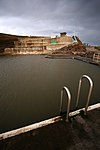Maer, Cornwall
Hamlets in CornwallNorth Cornwall geography stubsPopulated coastal places in Cornwall

Maer is a coastal hamlet in north Cornwall, England, United Kingdom. It is situated one mile (1.6 km) northeast of Bude at grid reference SS 205 075 in the civil parish of Bude-Stratton (where the 2011 census population is included.). The hamlet contains the only "known probable tithe barn" in Cornwall, which was extensively restored and modernised following a purchase in 2012. Its restoration, by architects The Bazeley Partnership, was featured on the Channel 4 programme Homes By the Sea.The National Trust maintains Maer Down and Maer Cliff immediately west of the hamlet. The South West Coast Path runs along the clifftop past Maer.
Excerpt from the Wikipedia article Maer, Cornwall (License: CC BY-SA 3.0, Authors, Images).Maer, Cornwall
Maer Lane,
Geographical coordinates (GPS) Address Nearby Places Show on map
Geographical coordinates (GPS)
| Latitude | Longitude |
|---|---|
| N 50.83912 ° | E -4.55075 ° |
Address
Maer Lane
Maer Lane
EX23 8NQ , Bude–Stratton
England, United Kingdom
Open on Google Maps









